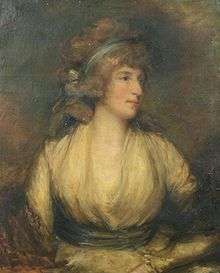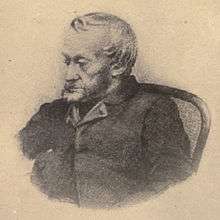William Stourton, 18th Baron Stourton

William Stourton, 18th Baron Stourton (1776–1846) was a Roman Catholic English peer. He is chiefly remembered for the private memoirs of his relative Maria Fitzherbert, the secret wife of King George IV, which she dictated to him, and which formed the basis for her first biography, published by his brother Charles Langdale in 1856.[1]
Family
He was the eldest son and successor of Charles Philip Stourton, 17th Baron Stourton; his mother was Mary Langdale, daughter of Marmaduke, 5th Baron Langdale (his brother Charles adopted their mother's surname). He was educated at the Jesuit College at Douai. LIke his brother Charles he was deeply committed to the cause of Catholic Emancipation, and was one of the first Roman Catholic peers to take his seat in the House of Lords after the achievement of Emancipation.
He married Catherine Weld, daughter of Thomas Weld of Lulworth Castle and his wife Mary Stanley-Massey; they had six children. Catherine was the sister of Cardinal Thomas Weld, and a niece by marriage of Mrs. Fitzherbert. William was succeeded as Baron by his eldest son Charles in 1846.
Memoirs of Maria Fitzherbert

William and Mrs Fitzherbert are said to have been distant cousins; a closer connection can be established through his wife, whose uncle George Weld was Mrs Fitzherbert's first husband. They were always on friendly terms, and she came to place great trust in him : she appointed him one of the executors of her will, and to act for her as her man of business generally, in her last years. Most crucially, he was one of her trustees who acted for her in regard to the destruction of her private papers. He was a witness on the celebrated occasion, 24 August 1833, when she pemitted the Duke of Wellington to burn a horde of her private papers relating to her secret marriage to George IV.[2] At her special request a number of documents which she particularly valued, including her marriage certificate, were preserved and deposited in Coutts Bank, sealed and witnessed by Stourton.[3]
Quite separate from these papers was the memoir which Mrs Fitzherbert dictated to Lord Stourton, and which he preserved. This contains invaluable evidence about her marriage to the future George IV, and of their years together. On one crucial and much debated subject- whether there were any children of the marriage- she remained reticent. Stourton, who attributed her reticence to "natural delicacy" apparently believed that she was implying that there were no children.
Soon after Mrs. Fitzherbert's death, Stourton took great offence at the publication of the Memoirs of Lord Holland, which claimed that she had never regarded herself as more than a royal mistress.[4] Stourton appealed to the Duke of Wellington to release the crucuial documents, including the certificate which proved that a marriage had taken place, and which were still in Coutts Bank (although the marriage violated the Royal Marriages Act 1772, the certificate would show that Mrs Fitzherbert was, according to the laws of her own Church, lawfully married). The Duke, acting on the wishes of Queen Victoria, who detested any reminder of the Fitzherbert marriage,[5] refused. The conscientious Stourton made several further appeals, but the Duke remained implacable.[6] William at his death entrusted his brother Charles with the task of publishing the truth about the royal marriage. Charles was unable to obtain the documents deposited in Coutts Bank, but he used his brother's memoir as the basis for his biography of Mrs. Fitzherbert, published in 1856.[7]

Notes
- ↑ Leslie, Anita Mrs Fitzherbert London Hutchinsons 1960 p.13
- ↑ Longford, Elizabeth Wellington-Pillar of State Weidenfeld and Nicholson 1972 p.288
- ↑ Leslie p.13
- ↑ Leslie p.13
- ↑ Apparently due to the rumours about children of the marriage, who might use the evidence of a lawful marriage to contest the succession.
- ↑ Longford p.319
- ↑ Leslie p.13
References
- Kidd, Charles and Williamson, David (editors). Debrett's Peerage and Baronetage (1995 edition). London: St. Martin's Press, 1995. ,
| Peerage of England | ||
|---|---|---|
| Preceded by Charles Philip Stourton |
Baron Stourton 1816–1846 |
Succeeded by Charles Stourton |